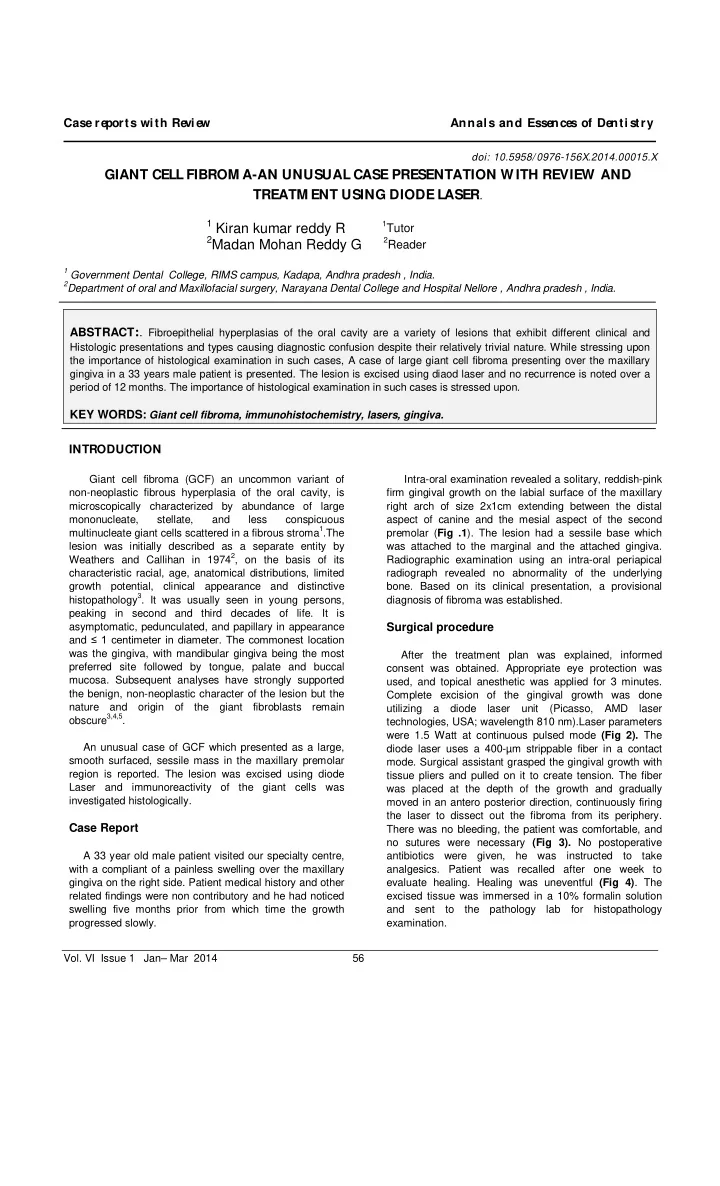

w Annals and Esse nti stry Case re ports with Re vi e nce s of De doi: 10.5958/ 0976-156X.2014.00015.X GIANT CELL FIBROM A-AN UNUSUAL CASE PRESENTATION W ITH REVIEW AND TREATM ENT USING DIODE LASER . 1 Kiran kumar reddy R 1 Tutor 2 Madan Mohan Reddy G 2 Reader 1 Government Dental College, RIMS campus, Kadapa, Andhra pradesh , India. 2 Department of oral and Maxillofacial surgery, Narayana Dental College and Hospital Nellore , Andhra pradesh , India. ABSTRACT : . Fibroepithelial hyperplasias of the oral cavity are a variety of lesions that exhibit different clinical and Histologic presentations and types causing diagnostic confusion despite their relatively trivial nature. While stressing upon the importance of histological examination in such cases, A case of large giant cell fibroma presenting over the maxillary gingiva in a 33 years male patient is presented. The lesion is excised using diaod laser and no recurrence is noted over a period of 12 months. The importance of histological examination in such cases is stressed upon. KEY WORDS: Giant cell fibroma, immunohistochemistry, lasers, gingiva. INTRODUCTION Giant cell fibroma (GCF) an uncommon variant of Intra-oral examination revealed a solitary, reddish-pink non-neoplastic fibrous hyperplasia of the oral cavity, is firm gingival growth on the labial surface of the maxillary microscopically characterized by abundance of large right arch of size 2x1cm extending between the distal mononucleate, stellate, and less conspicuous aspect of canine and the mesial aspect of the second multinucleate giant cells scattered in a fibrous stroma 1 .The premolar ( Fig .1 ). The lesion had a sessile base which lesion was initially described as a separate entity by was attached to the marginal and the attached gingiva. Weathers and Callihan in 1974 2 , on the basis of its Radiographic examination using an intra-oral periapical characteristic racial, age, anatomical distributions, limited radiograph revealed no abnormality of the underlying growth potential, clinical appearance and distinctive bone. Based on its clinical presentation, a provisional histopathology 3 . It was usually seen in young persons, diagnosis of fibroma was established. peaking in second and third decades of life. It is asymptomatic, pedunculated, and papillary in appearance Surgical procedure and ≤ 1 centimeter in diameter. The commonest location was the gingiva, with mandibular gingiva being the most After the treatment plan was explained, informed preferred site followed by tongue, palate and buccal consent was obtained. Appropriate eye protection was mucosa. Subsequent analyses have strongly supported used, and topical anesthetic was applied for 3 minutes. the benign, non-neoplastic character of the lesion but the Complete excision of the gingival growth was done nature and origin of the giant fibroblasts remain utilizing a diode laser unit (Picasso, AMD laser obscure 3,4,5 . technologies, USA; wavelength 810 nm).Laser parameters were 1.5 Watt at continuous pulsed mode (Fig 2). The An unusual case of GCF which presented as a large, diode laser uses a 400-µm strippable fiber in a contact smooth surfaced, sessile mass in the maxillary premolar mode. Surgical assistant grasped the gingival growth with region is reported. The lesion was excised using diode tissue pliers and pulled on it to create tension. The fiber Laser and immunoreactivity of the giant cells was was placed at the depth of the growth and gradually investigated histologically. moved in an antero posterior direction, continuously firing the laser to dissect out the fibroma from its periphery. Case Report There was no bleeding, the patient was comfortable, and no sutures were necessary (Fig 3). No postoperative A 33 year old male patient visited our specialty centre, antibiotics were given, he was instructed to take with a compliant of a painless swelling over the maxillary analgesics. Patient was recalled after one week to gingiva on the right side. Patient medical history and other evaluate healing. Healing was uneventful (Fig 4) . The related findings were non contributory and he had noticed excised tissue was immersed in a 10% formalin solution swelling five months prior from which time the growth and sent to the pathology lab for histopathology progressed slowly. examination. Vol. VI Issue 1 Jan– Mar 2014 56
w Annals and Esse nti stry Case re ports with Re vi e nce s of De Fig.2. Diode laser unit Fig.1.Photograph showing gingival growth irt to 13,14. Fig.4. Photograph after healing Fig.3. No bleding on excision Fig.6. All Giant cells with strong positivity for Fig.5. Haematoxyphilic cytoplasm of Giant cells vimentin HandE stained sections of the excised mass showed a Clone V9, Dako, Denmark.) and showed negative reaction hyperplastic epithelium with elongated and anastomosing for s-100 (Polyclonal Rabbit, Anti-S100, Dako) (Fig 6). rete processes covering a variedly mature fibrous connective tissue stroma. Abundantly distributed stellate Discussion giant cells and few multinucleated cells were noted, especially in the lamina propria beneath the basal layer. Though the distinction of GCF as a separate entity is The cytoplasm of these giant cells was haematoxyphilic been disputed over the years, various authors and and sometimes a peripheral separation of connective textbooks have adhered to the separate designation tissue from the cells was noted (Fig 5). A diagnosis of because of the distinct features both clinically and giant cell fibroma is arrived at and the immunoreactivity of histologically it presents with. the giant cells was further investigated following standard recommended procedures. All stellate giant and Many giant cell fibromas are misdiagnosed clinically as multinucleated giant cells showed strong positivity for papillomas due to their caulifiower-like appearance. They vimentin (ready-to-use, mouse monoclonal, Anti-Vimentin, may clinically resemble other common hyperplastic, Vol. VI Issue 1 Jan– Mar 2014 57
Recommend
More recommend